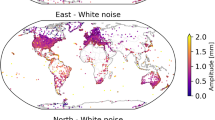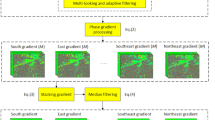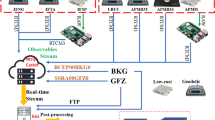Abstract
Ionospheric scintillation is an important phenomenon affecting GNSS positioning accuracy. Scintillation parameters, S4 and σφ, are usually used to characterize scintillation in amplitude and phase, respectively. S4 and σφ can be contaminated by multipath effects in certain circumstances. Similarly, the multipath parameter (MP) can also be affected by scintillation. Therefore, it is difficult to distinguish whether an increase in the scintillation parameters and MP is caused by scintillation or multipath. However, it is important to know the type of interference to apply appropriate mitigation measures. It is known that the multipath effect is periodic as compared to scintillation if the receiver location is fixed. Based on this peculiar feature, this article proposes to use parameters MP, S4, σφ and the rate of change of total electron content index (ROTI) characterize the receiver station surroundings so that multipath and scintillation effects can be distinguished. The Global Positioning System (GPS) data for two one-month records at two pairs of low-latitude stations, namely SAO0P-SJCU and SJCU-SJCE, located in Sao Paulo, Brazil, were used to generate elevation layered plots and parameter values against elevation and azimuth (PEA) plots for each satellite on each day. The second station was used as a reference for validating the conclusion. The results provide evidence that the proposed methodology can identify all multipath, scintillation and hybrid (of multipath and scintillation) events using scintillation indices and identify some multipath, scintillation and hybrid events using MP and ROTI. For hybrid events below 30° elevation, this methodology is not effective.











Similar content being viewed by others
Data Availability
The GNSS data at the SJCU and SJCE stations were provided by Projects CIGALA and CALIBRA which can be accessed from https://ismrquerytool.fct.unesp.br/is/ismrtool/retrieval/download_ismr.php?lan=en. The GNSS data at the SAO0P station were provided by INGV which can be accessed from http://www.eswua.ingv.it/index.php/data-access-and-policy/download-tools. The datasets analyzed during the current study are available from the corresponding author on reasonable request.
References
Acharya R, Majumdar S (2019) Statistical relation of scintillation index S4 with ionospheric irregularity index ROTI over Indian equatorial region. Adv Space Res 64(5):1019–1033. https://doi.org/10.1016/j.asr.2019.05.018
Avram A, Schwieger V, El Gemayel N (2019) Experimental results of multipath behavior for GPS L1–L2 and Galileo E1–E5b in static and kinematic scenarios. J Appl Geodesy 13(4):279–289. https://doi.org/10.1515/jag-2019-0010
Barnett V, Lewis T (1994) Outliers in Statistical Data, Chichester. John Wiley & Sons
Basu S, Groves KM, Quinn JM, Doherty P (1999) A comparison of TEC fluctuations and scintillations at Ascension Island. J Atmos Solar Terr Phys 61(16):1219–1226. https://doi.org/10.1016/S1364-6826(99)00052-8
Bhattacharyya A, Beach TL, Basu S, Kintner PM (2000) Nighttime equatorial ionosphere: GPS scintillations and differential carrier phase fluctuations. Radio Sci 35(1):209–224. https://doi.org/10.1029/1999RS002213
Carrano CS, Groves KM, Rino CL (2019) On the relationship between the rate of change of total electron content index (ROTI), Irregularity Strength (CkL), and the Scintillation Index (S4). J Geophys Res Space Phys 124(3):2099–2112. https://doi.org/10.1029/2018JA026353
Chousianitis K, Argyrakis P, Tsimi C, Papanikolaou M, Papathanassiou G, Exarchos K (2016) Monitoring of surface displacements in the kalochori area (Thessaloniki, Greece) using a local GNSS network. Bull Geol Soc Greece 50(3):1553–1562. https://doi.org/10.12681/bgsg.11869
de Bakker PF, Tiberius CCJM (2017) Real-time multi-GNSS single-frequency precise point positioning. GPS Solutions 21(4):1791–1803. https://doi.org/10.1007/s10291-017-0653-2
de Paula ER et al (2019) Ionospheric irregularity behavior during the September 6–10, 2017 magnetic storm over Brazilian equatorial–low latitudes. Earth, Planets Space 71(42):1–15. https://doi.org/10.1186/s40623-019-1020-z
Delay S, Carrano C, Groves K, Doherty P. (2015). A statistical analysis of GPS L1, L2, and L5 tracking performance during ionospheric scintillation. In: Proceedings of the ION 2015 Pacific PNT Meeting, Institute of Navigation, Honolulu, Hawaii, USA, April 20–23, 1–9
Demyanov VV, Yasyukevich YV, Jin S, Sergeeva MA (2019) The second-order derivative of GPS carrier phase as a promising means for ionospheric scintillation research. Pure Appl Geophys 176(10):4555–4573. https://doi.org/10.1007/s00024-019-02281-6
Demyanov V, Sergeeva M, Fedorov M, Ishina T, Gatica-Acevedo VJ, Cabral-Cano E (2020) Comparison of TEC calculations based on trimble, Javad, Leica, and Septentrio GNSS receiver data. Remote Sensing 12(19):3268. https://doi.org/10.3390/rs12193268
Van Dierendonck AJ, Klobuchar JA., Hua Q. (1993). Ionospheric scintillation monitoring using commercial single frequency C/A Code receivers. In: Procceeding ION ITM 1993, Institute of Navigation, Salt Lake City, UT, USA, September 22–24, 1333–1342
Estey LH, Meertens CM (1999) TEQC: The multi-purpose toolkit for GPS/GLONASS data. GPS Solutions 3(1):42–49. https://doi.org/10.1007/PL00012778
Guo K, Zhao Y, Liu Y, Wang J, Zhang C, Zhu Y (2017) Study of ionospheric scintillation characteristics in Australia with GNSS during 2011–2015. Adv Space Res 59(12):2909–2922. https://doi.org/10.1016/j.asr.2017.03.007
Hamm NAS, Atkinson PM, Milton EJ (2012) A per-pixel, non-stationary mixed model for empirical line atmospheric correction in remote sensing. Remote Sens Environ 124:666–678. https://doi.org/10.1016/j.rse.2012.05.033
Imam R, Dovis F. (2020). Distinguishing Ionospheric Scintillation from Multipath in GNSS Signals Using Bagged Decision Trees Algorithm. In: 2020 IEEE international conference on wireless for space and extreme environments (WiSEE 2020), Vicenza, Italy, October 12–14, 83–88.
Jiao Y, Morton YT (2015) Comparison of the effect of high-latitude and equatorial ionospheric scintillation on GPS signals during the maximum of solar cycle 24. Radio Sci 50(9):886–903. https://doi.org/10.1002/2015RS005719
Li C, Hancock CM, Hamm NAS, Sreeja V, You C (2020) Analysis of the relationship between scintillation parameters. Multipath ROTI Sensors 20(10):2877. https://doi.org/10.3390/s20102877
Luo X, Gu S, Lou Y, Cai L, Liu Z (2020) Amplitude scintillation index derived from C/N0 measurements released by common geodetic GNSS receivers operating at 1 Hz. J Geodesy 94:27. https://doi.org/10.1007/s00190-020-01359-7
McCaffrey AM, Jayachandran PT (2017) Spectral characteristics of auroral region scintillation using 100 Hz sampling. GPS Solutions 21(4):1883–1894. https://doi.org/10.1007/s10291-017-0664-z
Nguyen VK, Rovira-Garcia A, Juan JM, Sanz J, González-Casado G, La TV, Ta TH (2019) Measuring phase scintillation at different frequencies with conventional GNSS receivers operating at 1 Hz. J Geodesy 93(10):1985–2001. https://doi.org/10.1007/s00190-019-01297-z
Oliveira Nascimento Brassarote G, Souza EM, Monico JF (2017) S4 index: Does it only measure ionospheric scintillation? GPS Solutions 22:1–8. https://doi.org/10.1007/s10291-017-0666-x
Olwendo JO, Cilliers P, Weimin Z, Ming O, Yu X (2018) Validation of ROTI for ionospheric amplitude scintillation measurements in a low-latitude region over Africa. Radio Sci 53(7):876–887. https://doi.org/10.1029/2017RS006391
Olwendo J, Baki, P, Mito C, Doherty P. (2010). Elimination of superimposed Multipath effects on Scintillations index on solar quiet ionosphere at Low Latitude over the Kenyan Airspace from a lone Positioned SCINDA system. In: Proceedings of the 23rd international technical meeting of the satellite division of the institute of navigation, the Institute of Navigation, Portland, Oregon, USA, September 21–24, 386–392
Pi X, Mannucci AJ, Lindqwister UJ, Ho CM (1997) Monitoring of global ionospheric irregularities using the Worldwide GPS network. Geophys Res Lett 24(18):2283–2286. https://doi.org/10.1029/97GL02273
Pirsiavash A, Broumandan A, Lachapelle G, O’Keefe K (2018) GNSS code multipath mitigation by cascading measurement monitoring techniques. Sensors 18(6):1967. https://doi.org/10.3390/s18061967
Rodrigues FS, Moraes AO (2019) ScintPi: A low-cost, easy-to-build GPS Ionospheric scintillation monitor for DASI studies of space weather, education, and citizen science initiatives. Earth Space Sci 6(8):1547–1560. https://doi.org/10.1029/2019EA000588
Romano V, Spogli L, Aquino M, Dodson A, Hancock C, Forte B (2013) GNSS station characterisation for ionospheric scintillation applications. Adv Space Res 52(7):1237–1246. https://doi.org/10.1016/j.asr.2013.06.028
Sergeeva MA et al (2021) Assessment of Morelian meteoroid impact on Mexican environment. Atmosphere 12(2):185. https://doi.org/10.3390/atmos12020185
Smyrnaios M, Schön S, Nicolás ML. (2013). Multipath propagation, characterization and modeling in GNSS. In: JIN, S. (Eds.) Geodetic Sciences - Observations, Modeling and Applications. InTech
Spogli L et al (2014) A filtering method developed to improve GNSS receiver data quality in the CALIBRA project. In: Notarpietro R, Dovis F, Franceschi GD, Aquino M (eds) Mitigation of ionospheric threats to GNSS: an appraisal of the scientific and technological outputs of the TRANSMIT project. IntechOpen, London
Sreeja VV et al (2011) Tackling ionospheric scintillation threat to GNSS in Latin America. J Space Weather Space Climate 1:A05. https://doi.org/10.1051/swsc/2011005
Upper atmosphere physics and radiopropagation Working Group, Cesaroni C, De Franceschi G, Marcocci C, Pica E, Romano V, Spogli L (2020) Electronic Space Weather upper atmosphere database (eSWua) - GNSS scintillation data, version 10. Istituto Nazionale di Geofisica e Vulcanologia (INGV). https://doi.org/10.13127/eswua/gnss
Vilà-Valls J, Linty N, Closas P, Dovis F, Curran JT (2020) Survey on signal processing for GNSS under ionospheric scintillation: detection, monitoring, and mitigation. Navigation 67(3):511–536. https://doi.org/10.1002/navi.379
Yang Z, Liu Z (2016) Correlation between ROTI and ionospheric scintillation indices using Hong Kong low-latitude GPS data. GPS Solutions 20(4):815–824. https://doi.org/10.1007/s10291-015-0492-y
Zhao D, Li W, Li C, Hancock CM, Roberts GW, Wang Q (2022) Analysis on the ionospheric scintillation monitoring performance of ROTI extracted from GNSS observations in high-latitude regions. Adv Space Res 69(1):142–158. https://doi.org/10.1016/j.asr.2021.09.026
Acknowledgements
We acknowledge the University of Nottingham Ningbo China Faculty of Science and Engineering for provision of a Ph.D. scholarship (17053FOSE) to C.L. as well as further support through a new researchers grant to N.A.S.H. and C.M.H. Monitoring stations from the network were deployed in the context of the Projects CIGALA and CALIBRA, both funded by the European Commission (EC) in the framework of the FP7-GALILEO-2009-GSA and FP7–GALILEO–2011–GSA–1a, respectively, and FAPESP Project Number 06/04008-2, and now it is maintained by the INCT GNSS NavAer, with financial support of CNPq (Grant 465648/2014-2), FAPESP (Grant 2017/50115-0) and CAPES (23038.000776/2017-54). We acknowledge eSWua system (www.eswua.ingv.it) owned by the Istituto Nazionale di Geofisica e Vulcanologia (INGV) and operated by the Upper Atmosphere Physics and Radiopropagation group for providing data from SAO0P station. This project was further supported by the Natural Science Foundation of Jiangsu Province (No. BK20200664) and Key Laboratory of Geospace Environment and Geodesy, Ministry of Education, Wuhan University (No. 20-01-09)
Author information
Authors and Affiliations
Corresponding author
Additional information
Publisher's Note
Springer Nature remains neutral with regard to jurisdictional claims in published maps and institutional affiliations.
Supplementary Information
Below is the link to the electronic supplementary material.
Rights and permissions
Springer Nature or its licensor holds exclusive rights to this article under a publishing agreement with the author(s) or other rightsholder(s); author self-archiving of the accepted manuscript version of this article is solely governed by the terms of such publishing agreement and applicable law.
About this article
Cite this article
Li, C., Hancock, C.M., Vadakke Veettil, S. et al. Distinguishing ionospheric scintillation from multipath in GNSS signals using geodetic receivers. GPS Solut 26, 150 (2022). https://doi.org/10.1007/s10291-022-01328-x
Received:
Accepted:
Published:
DOI: https://doi.org/10.1007/s10291-022-01328-x




